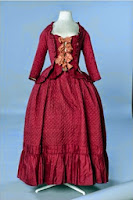Philippe was born on 21 September 1640 to the astonished Louis XIII and Anne of Austria - the couple had been childless for over a decade when Louis was born and the birth of Philippe only cemented the good luck that suddenly shone on the marriage.

During most of his childhood Philippe was known as "le Petit Monsieur" since there was already a man (his uncle) who held the title of Monsieur. It would appear that Philippe was a handsome child and intelligent too. There was something odd, however, to the way he was brought up. Since Anne of Austria had annulled Louis XIII's will it was her and Cardinal Mazarin who ruled - and Anne had personal charge of the children. She would often encourage Philippe to dress in clothing usually used for little girls!
But maybe Philippe was not completely forced into girls' clothing. His fondness for female attires continued well into his adolescence and he would often be seen attending balls wearing gowns. Philippe is one of the most famous (or rather infamous) homosexuals at the court of Versailles. Rather than trying to suppress what was seen as an abominable sin Anne of Austria - and later Louis XIV - used Philippe's sexuality to secure Louis' hold on the throne. If Philippe's homosexuality was widely known it would as good as deny him the crown in the case of Louis XIV's death. So, Philippe was welcome to carry out with his affairs - which he certainly did.
It might seem as if the King's younger brother had all the freedom he could wish for but that was not quite so. Anne of Austria and Cardinal Mazarin made sure that Philippe was completely dependent on the crown - and with it, his brother. Even if he had wanted to (which there is no evidence to suggest) he would not have been able to challenge his brother's throne.

After the Fronde had ended it was decided that Philippe should live in the Tuileries with his own household. When Louis XIV came of age, Philippe himself placed the crown on his brother's head. Whether he envied his brother or not is not for us to say but he certainly loved the pomp of it all. Through all his life Philippe maintained a fondness for ceremony and etiquette.
By the age of 18 the first rumours began to emerge of Philippe's liaisons with other men - but with women as well. So, perhaps Monsieur was bisexual rather than homosexual?
Either way, Philippe was to marry and marry he did. On 31 March 1661 he was married to Henrietta of England but the marriage was never a happy one and it certainly did not help that Henrietta was openly flirting with Louis - and later seduced Philippe's own lover! Besides their difficulties the couple still managed to produce four children of which two daughters survived into adulthood. The following year the couple made the Palais Royal their home rather than the Tuileries. The couple was never close and lived separately when Henrietta died in 1670.
Though the court mourned the death of Henrietta, Philippe did not and Louis was eager to see an heir produced for the Orlèans-line. Another marriage was arranged for Philippe this time to Elizabeth Charlotte of the Palatinate; the couple married in 1671. Unlike Philippe's first marriage this one got off to a good start. For the first few years the couple enjoyed living together and they produced three children of which two survived - including the much-longed for son. After the birth of their last child the couple mutually agreed to be no longer sleeping together.
In some aspects it would seem odd that a man such as Philippe would be eager for the battlefield but he was. Not only was Philippe pleased to be back on the battlefield in 1676 but he was skilled as well which he had already proven in previous campaigns. Actually, Philippe's skills as a commander and soldier was praised so highly that even his brother became jealous.

Back home Philippe emerged himself in his love for the arts (he was a patron for many upcoming artists including Lully) and would spent most of his time at his favourite residence of Saint-Cloud.
Philippe was a wealthy man in his own right due to intelligent management of his estates and decent investments. When his immensely wealthy cousin - known as Mademoiselle - died without an heir, he inherited her fortune as well. As for Philippe's own family it was peaceful. Both of his daughters from his first marriage became Queens and he maintained a close relationship with his other two children.
In his later years Philippe fell out with Louis over a matter concerning Philippe's son, the Duc de Chartres. At a dinner with Louis at Marly Philippe told Louis a couple of truths and pointed out that the Duc de Chartres had not received the favours promised when he married on the King's bidding. Louis was absolutely shocked. Philippe returned in anger to his beloved Saint-Cloud to spent time with none other than the Duc de Chartres. It was here that Philippe suffered a stroke on 9 June 1701 which became the death of him.


































































